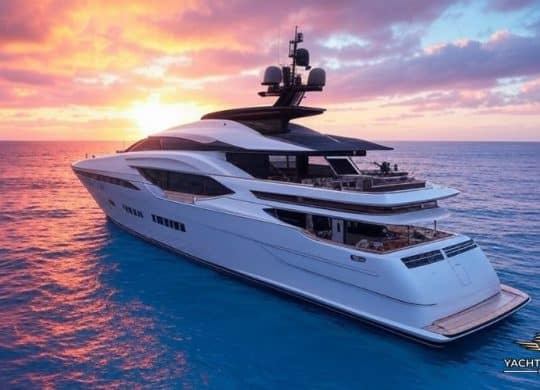Yacht Sizes
| Category | Size Range |
| Small Yachts | Up to 40 feet |
| Medium Yachts | 40 to 70 feet |
| Large Yachts | 70 to 100 feet |
| Super Yachts | 100 to 200 feet |
| Mega Yachts | Over 200 feet |
To determine a yacht’s size, start by measuring from the front to the back end, which gives you the overall length. Remember, this measurement, known as length overall (LOA), includes everything from the main deck to any forward-pointing parts or rear platforms.
The length of the part of the yacht that’s actually in the water is also measured, and it is called waterline length (LWL). You must consider other dimensions, such as the width (beam) and how deep it sits in the water (draft). Yachts are weighed without any liquids on board to get the dry weight and with all liquids for the wet weight. If you add all the gear, you get the loaded weight. These are one of the characteristics or parameters that mark the difference between yacht and cruise.
Yacht Dimensions
| Yacht Type | Length (ft) | Width (Beam) (ft) | Height (ft) | Draft (ft) | Gross Tonnage (GT) |
| Sailing Yachts | 30-100 | 8-20 | 10-30 | 0.2-5.9 | 5-150 |
| Motor Yachts | 35-200 | 12-30 | 15-40 | 3-7 | 50-500 |
| Catamarans | 30-60 | 15-30 | 10-35 | 1-5 | 20-120 |
| Trawlers | 40-80 | 15-25 | 10-35 | 3.5 | 30-200 |
| Explorer Yachts | 60-400 | 20-50 | 15-60 | 3.6-5.0 | 200-10000 |
How Do Yacht Sizes Impact Their Handling
Yacht size significantly affects handling. Due to increased length and displacement, larger yachts have more momentum and take longer to respond to steering and power changes. They require more space to maneuver and have larger blind spots, especially under the bows. Smaller yachts are generally more agile and responsive.
Small yachts are easy to handle and quickly change direction, perfect for navigating tight spots. Larger vessels, such as explorer yachts built for long-distance travel, need careful steering and more time to slow down or stop. They often come with extra features like thrusters for precise control.
The yacht’s width, or beam, keeps it steady on the water; however, a wider yacht might not move as swiftly or turn as easily. The draft, which is how deep the yacht goes under the water, is deeper for better performance against the wind, but it means the yacht can’t go into shallow areas. The yacht’s height affects how much wind it can catch, which helps determine how far a yacht can travel and makes it more challenging to handle.
Yacht Classification
| Yacht Type | Typical Use | Length Range |
| Commercial Yachts | Business, charters | 50-180 ft |
| Private Yachts | Personal use | 40-200 ft |
| Charter Yachts | Rented for vacations | 50-150 ft |
| Luxury Yachts | High-end private use | 70-300 ft |
| Sport Fishing Yachts | Angling, tournaments | 30-100 ft |
When you are looking to charter a yacht, buy one, or rent it for a getaway, picking the right size is essential. It is all about matching the yacht to what you need, whether that’s room for a big group, special features for comfort, or just the right feel.
The size you choose has a big impact on how easy the yacht is to handle, where you can take it, and how many friends or family can come along. In addition, it has got to fit your budget. Getting the size right means you will have a better time on the water and save money.
Choosing the Right Yacht Size – Final Words
In the world of yachting, size does matter. It influences everything from the yacht’s handling and maintenance to the overall onboard experience. Whether you are a seasoned sailor or a leisurely cruiser, understanding the dimensions and classifications of yachts ensures that you select a vessel that meets your needs and delivers the comfort and performance you desire.






